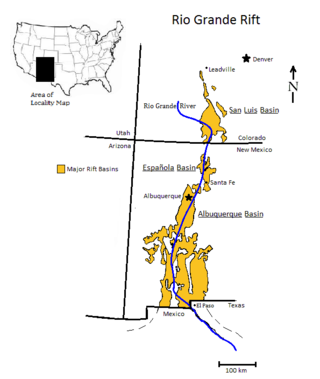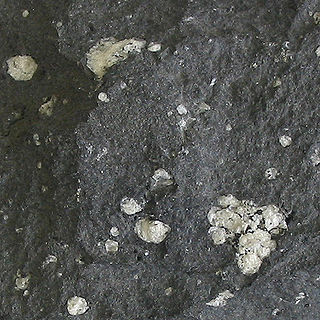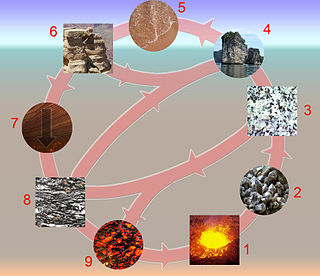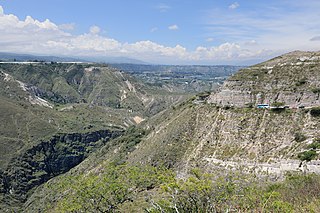Related Research Articles

The Rio Grande rift is a north-trending continental rift zone. It separates the Colorado Plateau in the west from the interior of the North American craton on the east. The rift extends from central Colorado in the north to the state of Chihuahua, Mexico, in the south. The rift zone consists of four basins that have an average width of 50 kilometres (31 mi). The rift can be observed on location at Rio Grande National Forest, White Sands National Park, Santa Fe National Forest, and Cibola National Forest, among other locations.

Subduction is a geological process in which the oceanic lithosphere and some continental lithosphere is recycled into the Earth's mantle at the convergent boundaries between tectonic plates. Where one tectonic plate converges with a second plate, the heavier plate dives beneath the other and sinks into the mantle. A region where this process occurs is known as a subduction zone, and its surface expression is known as an arc-trench complex. The process of subduction has created most of the Earth's continental crust. Rates of subduction are typically measured in centimeters per year, with rates of convergence as high as 11 cm/year.

A convergent boundary is an area on Earth where two or more lithospheric plates collide. One plate eventually slides beneath the other, a process known as subduction. The subduction zone can be defined by a plane where many earthquakes occur, called the Wadati–Benioff zone. These collisions happen on scales of millions to tens of millions of years and can lead to volcanism, earthquakes, orogenesis, destruction of lithosphere, and deformation. Convergent boundaries occur between oceanic-oceanic lithosphere, oceanic-continental lithosphere, and continental-continental lithosphere. The geologic features related to convergent boundaries vary depending on crust types.

Andesite is a volcanic rock of intermediate composition. In a general sense, it is the intermediate type between silica-poor basalt and silica-rich rhyolite. It is fine-grained (aphanitic) to porphyritic in texture, and is composed predominantly of sodium-rich plagioclase plus pyroxene or hornblende.

A mantle plume is a proposed mechanism of convection within the Earth's mantle, hypothesized to explain anomalous volcanism. Because the plume head partially melts on reaching shallow depths, a plume is often invoked as the cause of volcanic hotspots, such as Hawaii or Iceland, and large igneous provinces such as the Deccan and Siberian Traps. Some such volcanic regions lie far from tectonic plate boundaries, while others represent unusually large-volume volcanism near plate boundaries.

Continental crust is the layer of igneous, metamorphic, and sedimentary rocks that forms the geological continents and the areas of shallow seabed close to their shores, known as continental shelves. This layer is sometimes called sial because its bulk composition is richer in aluminium silicates (Al-Si) and has a lower density compared to the oceanic crust, called sima which is richer in magnesium silicate (Mg-Si) minerals. Changes in seismic wave velocities have shown that at a certain depth, there is a reasonably sharp contrast between the more felsic upper continental crust and the lower continental crust, which is more mafic in character.

Oceanic crust is the uppermost layer of the oceanic portion of the tectonic plates. It is composed of the upper oceanic crust, with pillow lavas and a dike complex, and the lower oceanic crust, composed of troctolite, gabbro and ultramafic cumulates. The crust overlies the rigid uppermost layer of the mantle. The crust and the rigid upper mantle layer together constitute oceanic lithosphere.

Forearc is a plate tectonic term referring to a region in a subduction zone between an oceanic trench and the associated volcanic arc. Forearc regions are present along convergent margins and eponymously form 'in front of' the volcanic arcs that are characteristic of convergent plate margins. A back-arc region is the companion region behind the volcanic arc.

A flood basalt is the result of a giant volcanic eruption or series of eruptions that covers large stretches of land or the ocean floor with basalt lava. Many flood basalts have been attributed to the onset of a hotspot reaching the surface of the Earth via a mantle plume. Flood basalt provinces such as the Deccan Traps of India are often called traps, after the Swedish word trappa, due to the characteristic stairstep geomorphology of many associated landscapes.

A large igneous province (LIP) is an extremely large accumulation of igneous rocks, including intrusive and extrusive, arising when magma travels through the crust towards the surface. The formation of LIPs is variously attributed to mantle plumes or to processes associated with divergent plate tectonics. The formation of some of the LIPs in the past 500 million years coincide in time with mass extinctions and rapid climatic changes, which has led to numerous hypotheses about causal relationships. LIPs are fundamentally different from any other currently active volcanoes or volcanic systems.

A mid-ocean ridge (MOR) is a seafloor mountain system formed by plate tectonics. It typically has a depth of about 2,600 meters (8,500 ft) and rises about 2,000 meters (6,600 ft) above the deepest portion of an ocean basin. This feature is where seafloor spreading takes place along a divergent plate boundary. The rate of seafloor spreading determines the morphology of the crest of the mid-ocean ridge and its width in an ocean basin.

The rock cycle is a basic concept in geology that describes transitions through geologic time among the three main rock types: sedimentary, metamorphic, and igneous. Each rock type is altered when it is forced out of its equilibrium conditions. For example, an igneous rock such as basalt may break down and dissolve when exposed to the atmosphere, or melt as it is subducted under a continent. Due to the driving forces of the rock cycle, plate tectonics and the water cycle, rocks do not remain in equilibrium and change as they encounter new environments. The rock cycle explains how the three rock types are related to each other, and how processes change from one type to another over time. This cyclical aspect makes rock change a geologic cycle and, on planets containing life, a biogeochemical cycle.
Tectonic–climatic interaction is the interrelationship between tectonic processes and the climate system. The tectonic processes in question include orogenesis, volcanism, and erosion, while relevant climatic processes include atmospheric circulation, orographic lift, monsoon circulation and the rain shadow effect. As the geological record of past climate changes over millions of years is sparse and poorly resolved, many questions remain unresolved regarding the nature of tectonic-climate interaction, although it is an area of active research by geologists and palaeoclimatologists.

Magmatic underplating occurs when basaltic magmas are trapped during their rise to the surface at the Mohorovičić discontinuity or within the crust. Entrapment of magmas within the crust occurs due to the difference in relative densities between the rising magma and the surrounding rock. Magmatic underplating can be responsible for thickening of the crust when the magma cools. Geophysical seismic studies utilize the differences in densities to identify underplating that occurs at depth.

Crustal recycling is a tectonic process by which surface material from the lithosphere is recycled into the mantle by subduction erosion or delamination. The subducting slabs carry volatile compounds and water into the mantle, as well as crustal material with an isotopic signature different from that of primitive mantle. Identification of this crustal signature in mantle-derived rocks is proof of crustal recycling.

River incision is the narrow erosion caused by a river or stream that is far from its base level. River incision is common after tectonic uplift of the landscape. Incision by multiple rivers result in a dissected landscape, for example a dissected plateau. River incision is the natural process by which a river cuts downward into its bed, deepening the active channel. Though it is a natural process, it can be accelerated rapidly by human factors including land use changes such as timber harvest, mining, agriculture, and road and dam construction. The rate of incision is a function of basal shear-stress. Shear stress is increased by factors such as sediment in the water, which increase its density. Shear stress is proportional to water mass, gravity, and WSS:

The plate theory is a model of volcanism that attributes all volcanic activity on Earth, even that which appears superficially to be anomalous, to the operation of plate tectonics. According to the plate theory, the principal cause of volcanism is extension of the lithosphere. Extension of the lithosphere is a function of the lithospheric stress field. The global distribution of volcanic activity at a given time reflects the contemporaneous lithospheric stress field, and changes in the spatial and temporal distribution of volcanoes reflect changes in the stress field. The main factors governing the evolution of the stress field are:
- Changes in the configuration of plate boundaries.
- Vertical motions.
- Thermal contraction.
Intraplate volcanism is volcanism that takes place away from the margins of tectonic plates. Most volcanic activity takes place on plate margins, and there is broad consensus among geologists that this activity is explained well by the theory of plate tectonics. However, the origins of volcanic activity within plates remains controversial.
Cynthia Ebinger is an American geoscientist at Tulane University known for her research on continental rifts and the movement of continental plate boundaries.

The Dharwar Craton is an Archean continental crust craton formed between 3.6-2.5 billion years ago (Ga), which is located in southern India and considered the oldest part of the Indian peninsula.
References
- ↑ Canup, R. M. (17 October 2012). "Forming a Moon with an Earth-like Composition via a Giant Impact". Science. 338 (6110): 1052–1055. Bibcode:2012Sci...338.1052C. doi:10.1126/science.1226073. PMC 6476314 . PMID 23076098.
- ↑ George, Williams (1991). "Upper Proterozoic Tidal Rhythmites, South Australia: Sedimentary Features, Deposition, and Implications for the Earth's Paleorotation". Clastic Tidal Sedimentology: 161–177. Retrieved 3 March 2015.
- ↑ Wired: Was the Earth a migratory planet?
- ↑ Marty, B.; Zimmermann, L.; Pujol, M.; Burgess, R.; Philippot, P. (19 September 2013). "Nitrogen Isotopic Composition and Density of the Archean Atmosphere". Science. 342 (6154): 101–104. arXiv: 1405.6337 . Bibcode:2013Sci...342..101M. doi:10.1126/science.1240971. PMID 24051244. S2CID 206550098.
- ↑ Egholm, David L.; Knudsen, Mads F.; Sandiford, Mike (26 June 2013). "Lifespan of mountain ranges scaled by feedbacks between landsliding and erosion by rivers". Nature. 498 (7455): 475–478. Bibcode:2013Natur.498..475E. doi:10.1038/nature12218. PMID 23803847. S2CID 4304803.
- ↑ Willenbring, Jane K.; Codilean, Alexandru T.; McElroy, Brandon (2013). "Earth is (mostly) flat: Apportionment of the flux of continental sediment over millennial time scales". Geology. 41 (3): 343–346. Bibcode:2013Geo....41..343W. doi:10.1130/G33918.1. S2CID 4364664.
- ↑ Sklar, Leonard S.; Dietrich, William E. (2001). "Sediment and rock strength controls on river incision into bedrock" (PDF). Geology. 29 (12): 1087. Bibcode:2001Geo....29.1087S. doi:10.1130/0091-7613(2001)029<1087:SARSCO>2.0.CO;2 . Retrieved 3 March 2015. (effect description and tools)
- ↑ Cowie, Patience A.; Whittaker, Alexander C.; Attal, Mikaël; Roberts, Gerald; Tucker, Greg E.; Ganas, Athanassios (2008). "New constraints on sediment-flux–dependent river incision: Implications for extracting tectonic signals from river profiles" (PDF). Geology. 36 (7): 535. Bibcode:2008Geo....36..535C. doi:10.1130/G24681A.1 . Retrieved 3 March 2015.(field example)
- ↑ Bony, Sandrine; Stevens, Bjorn; Frierson, Dargan MW; Jakob, Christian; Kageyama, Masa; Pincus, Robert; et al. (2015). "Clouds, circulation and climate sensitivity" (PDF). Nature Geoscience. 8 (4): 261–268. Bibcode:2015NatGe...8..261B. doi:10.1038/ngeo2398.
- ↑ Sobel, Adam H; Wing, Allison A; Camargo, Suzana J; Patricola, Christina M; Vecchi, Gabriel A; Lee, Chia-Ying; Tippett, Michael K; et al. (2021). "Tropical cyclone frequency". Earth's Future. 9 (12). doi:10.1029/2021EF002275.
- ↑ Caron, Etienne; Faridi, Pouya (2016). "To Investigate or Not to Investigate? Researchers' Views on Unexplored Atmospheric Light Phenomena". Frontiers in Earth Science. 4: 17. Bibcode:2016FrEaS...4...17C. doi: 10.3389/feart.2016.00017 . hdl: 20.500.11850/122680 . ISSN 2296-6463.
- ↑ Björkgren, Maria (2017). The Formation of Granite Magma Chambers in the Mourne Mountains, Northern Ireland.
- ↑ Kaus, B. J. P.; Reuber, G. S.; Popov, A.; Baumann, T. (2018). "Understanding the Yellowstone magmatic system using 3D geodynamic inverse models" (PDF). In: Geophysical Research Abstracts. Vol. 20.
- ↑ Lowrie, William (2007). Fundamentals of geophysics (2nd ed.). Cambridge University Press. p. 117. ISBN 9781139465953.
- ↑ Hirose, Kei; Karato, Shun-ichiro; Cormier, Vernon F.; Brodholt, John P.; Yuen, David A. (2006). "Unsolved problems in the lowermost mantle" (PDF). Geophysical Research Letters. 33 (12): L12S01. Bibcode:2006GeoRL..3312S01H. doi:10.1029/2006GL025691. S2CID 16779962.
- ↑ Zhang, Y.; Sekine, T.; He, H.; Yu, Y.; Liu, F.; Zhang, M. (2016). "Experimental constraints on light elements in the Earth's outer core". Scientific Reports. 6: 22473. Bibcode:2016NatSR...622473Z. doi:10.1038/srep22473. PMC 4773879 . PMID 26932596.
- 1 2 Olson, P. (December 2016). "A Mission to Earth's Center". American Geophysical Union, Fall General Assembly 2016, Abstract Id. DI23C-08. 2016: DI23C–08. Bibcode:2016AGUFMDI23C..08O.